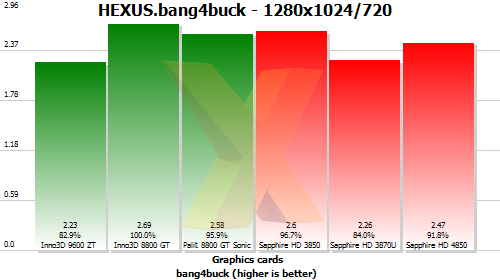HEXUS.bang4buck, temperatures, overclocking
HEXUS.bang4buck
In a rough-and-ready assessment of the cards' bang per buck, we've aggregated the 1,280x1,024/720 frame-rates for the three games, also including Company of Heroes DX10, normalised them* and taken account of listed the cards' prices.
But there are more provisos than we'd care to shake a stick at. We could have chosen three different games, the cards' prices could have been derived from other sources and pricing tends to fluctuate daily.
Consequently, the table and graph below highlight a metric that should
only be used as a yardstick for evaluating comparative performance with
price factored in. Other architectural benefits are not covered,
obviously.
| Graphics cards | Inno3D iChiLL 9600 GT ZEROtherm | Inno3D 8800GT 512MB | Palit 8800 GT 512MB Sonic OC | Sapphire Radeon HD 4850 512 | Sapphire HD 3850 512 | Sapphire Radeon HD 3870 ULTIMATE 512MiB |
|---|---|---|---|---|---|---|
| Actual aggregate marks at 1,280x1,024/720 | 297.58 | 356.37 | 377.2 | 377.68 | 249.14 |
285.6 |
| Aggregate marks, normalised*, at 1,280x1,024/720 | 256.6 | 293.61 | 307.43 | 308.85 | 220.75 |
244.12 |
| Current pricing, including VAT | £115 |
£109 | £119 | £125 |
£85 |
£108 |
| HEXUS.bang4buck score at 1,280x1,024/720 | 2.23 | 2.69 | 2.58 | 2.47 | 2.6 |
2.26 |
| Acceptable frame-rate (av. 60fps) at 1,280x1,024/720 | No (CoH DX10) | No (CoH DX10) | No (CoH DX10) | Yes | No (CoH DX10) | No (CoH DX10) |
* The normalisation refers to taking playable frame rate into account. Should a card benchmark at over 60 frames per second in any one game, the extra fps count as half. Similarly, should a card benchmark lower, say at 40fps, we deduct half the difference from its average frame rate and the desired 60fps, giving it a bang4buck score of 30 marks. The minimum allowable frame rate is 20fps but that scores zero.
As an example, should a card score 120fps we treat it as 90fps as only half the frame rate above 60fps is counted for the bang4buck - this is the formula: (120-((120-60)/2)). Similarly, should it score 30fps, we count it as only 15fps: (30+((30-60)/2)).
The reasoning behind such calculation lies with playable frame rates.
Should card A score 110fps in a benchmark and card B 160, then card B would otherwise receive an extra 50 marks in our bang4buck assessment, even though both cards produce perfectly playable frame rates and anything above 60fps is a bonus and not a necessity for most.
Similarly, without our adjustments, the aggregated bang4buck total for two very different cards would be identical if, in a further benchmark, card A scored a smooth 70fps and card B an unplayable 20fps. Both would win marks totally 180, yet the games-playing experience would be vastly different.
A more realistic (and useful) assessment would say that card A is better because it ran smoothly in both games - and that view would be accurately reflected in our adjusted aggregation, where card A would receive 150 marks (85+65) and card B 100 (100+0).
In effect, we're including a desired average frame rate, in this case 60, and penalising lower performance while giving frame rates higher than 60fps only half as much credit as those up to 60fps. If this doesn't make sense or you have issue with it, please hit the HEXUS community.
Here's the HEXUS.bang4buck graph at 1,280x1,024/720.

The graph divides the normalised score by the price.
A few things to note here. The Radeon HD 4850 is barely extended with our mid-range settings and doesn't show itself until the image quality and resolution is turned way up. Have a look for a comparison against other high-end GPUs.
GeForce 8800 GTs offer more performance for around the same money, hence their higher metric, and the economical Radeon HD 3850, whilst not the best performer, also looks good, costing some £30 less than the Inno3D card.
Still, any metric above the value of two is good, and the HEXUS.bang4buck doesn't take into account the quality of the cooler.
Temperature musings
We perform our testing in an open test bed, with a 120mm fan simulating case airflow.
| Graphics cards | Inno3D iChiLL 9600 GT ZEROtherm | Inno3D 8800GT 512MB | Palit 8800 GT 512MB Sonic OC | Sapphire Radeon HD 4850 512 | Sapphire HD 3850 512 | Sapphire Radeon HD 3870 ULTIMATE 512MiB |
|---|---|---|---|---|---|---|
| Ambient temperature | 24.5°C | 21°C | 22°C | 21°C | 18°C | 22.5°C |
| Idle temperature | 32°C | 52°C | 47°C | 71°C | 45°C | 46°C |
| Load temperature | 42°C | 74°C | 60°C | 81°C | 73°C | 70°C |
| Ambient-to-load delta | 17.5°C | 53°C | 38°C | 60°C | 55°C | 47.5°C |
Bear in mind that the Sapphire Radeon HD 3870 ULTIMATE ships with no fan.
The ZEROtherm Hurricane cools the GeForce 9600 GT with consummate ease, producing, by far, the best idle-to-load delta out of the six cards. It's quiet when plying its trade, which is a bonus.
No card is particularly bad, although the Radeon HD 4850's idle temperature is alarmingly high. Also, ignoring the zero-noise HD 3870 ULTIMATE for obvious reasons, none make a particularly loud din when under load.









